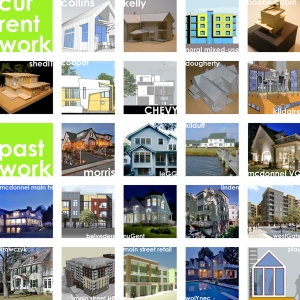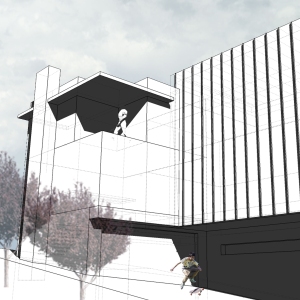Hiring an Architect: Part 1- The Search
So you want to hire an architect, who doesn’t right? But how should a residential client go about finding and hiring an architect? Well, you’ve come to the right place. Part one of a three part series discusses how a residential client can find and hire an architect. While the process for most commercial projects is similar, this series is aimed at the residential client who is most likely hiring an architect for the first time. Once you’ve selected your architect, you can have in-depth discussions pertaining to your project specifics and their process.
I’m assuming that as a client you’ve already determined the value that an architect can bring to your project- if not, be sure to read Architect’s Value? 60 to Contemplate. The good news is that you understand the importance of an architect and now you’re ready to find one suitable for your project. Where to start? There are many resources to assist you in finding an architect. The most readily available is to talk with friends and neighbors who have completed projects similar to yours. Online research is another great tool, your local chapter of the American Institute of Architects (AIA) is a good resource for locating architects. You can go to the national AIA website and search for your local chapter. The local chapter web site should contain a list of local architects along with bios and their areas of expertise. It is worth noting that membership in the AIA is voluntary. Just being an AIA member does not guarantee that they are the best, or better than another, architect for your project. It’s also worth noting that one does not need to be an AIA member to be an architect. Additionally, numerous sites exist, such as Houzz, that allow you to view local architect’s work and obtain contact information. In addition, Houzz is a great site for you to start- if you haven’t already- collecting images that appeal to you and what you wish for in your own project. You can also search for ‘architects <insert your city here>’ on a search engine of your choice. Visit the architect’s web sites and view their portfolio of work. Using these three methods should yield enough information to compile a list of potential architects.
Now what- you’ve talked to friends and neighbors, viewed numerous websites, looked at online portfolios, and found architects whose work you like- is it over? Nope, you’ve got some more research to do. Selecting the right architect is very important. You’ll be dealing with the architect for several months if not longer. Trust is paramount between you and your architect. You need to have confidence, and yes a bit of faith, in your architect. Your research should have resulted in a list of architects you feel are appropriate for your project. I recommend interviewing the top three from your list. Ask lots of questions. Not sure what to ask? No worries, in Parts 2 and 3 I’ll give you some suggested questions to get the discussions started. Obtain a list of references from the potential architects and call them. I know, I know, nobody lists a bad reference. However, you should still call them… by call, I mean no email or letter, actually speak with the person. Ask them anything you feel necessary. For the final question, ask the following “If you were to do it over again, what would you change about the process?” The response should reveal whether or not the architect in question will be a good fit for you.
Having a discussion about architectural fees with the potential architects will serve as another gauge as to how well you can communicate with, and what the working relationship will be like. There are four basic ways architectural fees can be calculated- percentage of construction cost, hourly fee, fixed fee, or a hybrid of hourly and fixed fee. I won’t go into the specifics of each, perhaps a future post on the pros/cons of each. Your architect will describe their method(s) for determining fees and how/when you will be billed. As the client, you need to be honest with the architect about your budget for the project. In addition, you need to be aware of the difference between a Project Budget and a Construction Budget and be sure you’re both talking about the same budget. These discussions will be useful in determining if you and the architect will have a good working relationship and can have open honest communication.
Trust. I can’t state this enough, you need to trust your architect. You need to be comfortable in talking with them. You should be able to envision having meals with this person and inviting them to a party- architects love parties! You don’t have to be bff best friends with your architect; you do need to like them though. You need to have confidence in their integrity and skill set as an architect.
Armed with all your research, you can now select an architect for your project. If you read between the lines, it should be obvious that architectural fees shouldn’t be the deciding factor in your selection. You want an architect who has completed projects similar to yours, one who shares similar beliefs as you with regards to the project, and above all, one whom you trust. Have your architect forward a contract for your review. Ask the architect to clarify anything you don’t understand. Make sure all the fees, and what those fees cover, are clear. Be sure to understand what is not covered in the proposed fees and what may be constituted as an additional fee. While architectural services contracts for residential projects are typically straightforward, you always have the option of having a lawyer review your contract. When you’re satisfied with the contract, have come to an agreement on fees and schedule, sign the contract and return it to your architect… the fun’s about to begin!
Now that you’ve hired an architect for your project- what’s next in the process? Keep in mind, each architect will approach your project differently. This is how I work, and in general, most architects will adhere to a similar process. The typical design/construction process:
1. Programming– deciding what to build
2. Schematic Design– initial sketches and ideas
2a. Construction Budget vs. Project Budget
2b. Preliminary Construction Cost Estimate (PCCE)
3. Design Development– refining the design
4. Construction Documents- finalizing the working documents – (future post)
5. Construction Administration– construction phase of your project
Parts 2 and 3 of the ‘Hiring an Architect’ series will be posted soon. These posts will provide you with suggested questions to get discussions started between you and the architect.
Wow! This is starting to sound like a long process… it can be, however, it is also extremely rewarding. Your architect is there to represent you, your project, and your best interests, all while making the process fun! Along the way your architect will have educated you and made it an enjoyable experience. In addition, they may not admit it, but your architect will have learned from you and your project as well. In the end you’ll have the home you wanted because your architect was able to assist you in bridging the gap between your vision and reality. You’ll end up with a home that fits you and your lifestyle.
So go find yourself an architect, it will be worth it!
** You can always just contact me if you don’t want to search for an architect.







**fist bump**
Thanks for the reblog and the kind words, I appreciate it!
I see you’ve changed your logo, looks good.
yes, that’s a post about graphics that’s brewing
Reblogged this on think | architect and commented:
Keith has written the beginning of a great series. His style is informative but begins to get at the most important issue, trust. I wish I’d have written this, but here is a great article. I hope it is useful as you consider hiring an architect.
Pingback: Hiring an Architect: Part 2- Q&A Yourself | Architect's Trace
Pingback: Hiring an Architect: Part 3- Ask the Architect | Architect's Trace
Pingback: Hiring an Architect: Part 4- A is for ‘Architect’ | Architect's Trace
Pingback: Hiring an Architect: Part 5- What? Me, hire an architect? | Architect's Trace
Pingback: What now, a podcast? 2013 Blog Review | Architect's Trace